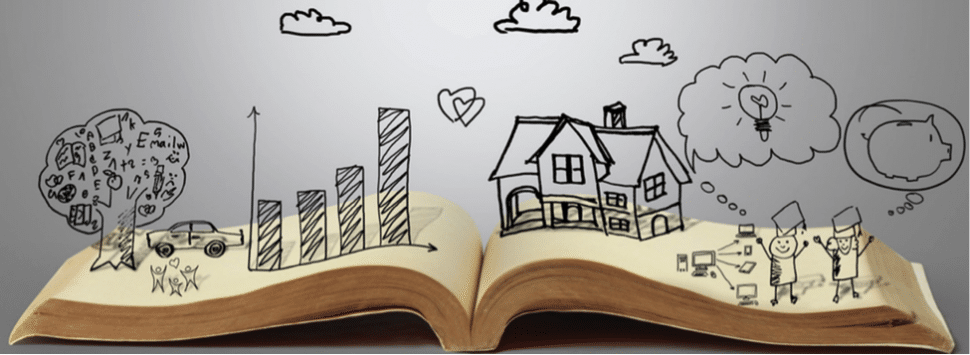By: Bianca Buliga, Content Curator
We are all bound by the human experience. We have all felt a vast array of emotions, ranging from heartbreak and disappointment to joy and triumph. Humankind has been communicating through storytelling for upwards of 20,000 years when our TVs were just cave walls! We are inherently attracted to stories – it’s how we relate to one other.
A story has the power to go where quantitative analysis is denied admission: our hearts. Data alone can persuade people, but it doesn’t inspire them to act. So how can social entrepreneurs create the most effective digital marketing strategies to grow their seed-stage ventures? By wrapping their passion in a story that fires the imagination and stirs the soul.
SHOW ME SOME SCIENCE
In a 2014 article published in the Harvard Business Review, neuroeconomist Paul Zak reveals that a well-constructed narrative triggers the release of three primary neurochemicals in our brain: oxytocin, cortisol, and dopamine – all of which elicit a distinct emotional response among listeners. For those of you scratching your heads, let me break it down for you.
1. Establishing Empathy
Produced in the brain’s hypothalamus and secreted by the pituitary gland, oxytocin is released during dating, sexual activity, childbirth, and breastfeeding. Within humans, oxytocin traditionally enhances feelings of relaxation, trust, and psychological stability. So why does oxytocin matter in a storytelling context?
Because it promotes connection, care, and empathy between audience and storyteller. Oftentimes, oxytocin can make people feel more generous and increases their likelihood of donating to people they’ve never met! This powerful hormone also makes people more susceptible to advertising, which explains the clever technique of using puppies and babies to empty our wallets. You know that Sarah McLachlan commercial with the sad animals staring into your soul? I’m not crying, you’re crying!

2. Building Tension
Produced in the brain’s adrenal cortex as a response to physical or emotional stress, cortisol helps us deal with stress by shutting down unnecessary functions, like reproduction or our immune systems, in order to allow the body to direct 100% of its energy to dealing with our stressors.
Essentially, cortisol is responsible for the side effects that occur while you’re watching a suspenseful movie. Whenever you watch James Bond scale a skyscraper or drive through massive flames on a motorcycle, your blood pressure increases, your heart is pounding, and you start to sweat. Our brains produce cortisol during the tense moments of a story to engage the audience’s attention.
3. Ending on a High Note
Functioning as a neurotransmitter, dopamine is synthesized by our dietary intake of an amino acid called tyrosine, which is found in protein-rich foods like meats and cheeses. Many scientists believe dopamine release is linked with motivation, addiction, and feelings of reward.
Exhibit A: your cliché romantic comedy (insert any Nicholas Sparks book/movie here). Exhibit B: you on your couch eating Ben and Jerry’s. Now fast forward 90 minutes to when you finally see the couple happily run off into the sunset forever! This happy ending triggers the limbic system, or our brain’s reward center, to release dopamine and make us feel hopeful and optimistic about the future.
SO, THE THREE IN CONJUNCTION…?
Activating empathy, tension, and a happy ending during your story can have incredible outcomes! Strategic storytelling has the power to radically shift existing attitudes and behaviors. Studies from the healthcare industry indicate that many medical students dread treating dementia patients because of the difficulties that can arise. However, after participating in storytelling exercises, most students felt far more sympathetic to the plight of dementia patients and adjusted their attitudes accordingly.
HOW TO BUILD YOUR OWN STORY
Identify your personal narrative. How did you realize your passions? When was the specific moment you were called to action? How was your company brought to life from these realizations?
Create a relatable character. It could be you, an innocent being treated unfairly, or a protector who seeks to right the wrong! Studies show that character-driven stories consistently cause more oxytocin synthesis, especially if the story is told through video. As the story develops, audiences come to share the emotions of the character – a process that transcends cultural, religious, or even linguistic barriers. Learning someone’s story is crucial in forming relationships with strangers.
Construct the story powerfully. Believe it or not, the most successful stories often focus listeners’ minds on a single important idea and take no longer than 30 seconds to forge an emotional connection. The most effective format is found in Freytag’s dramatic arc:
Freytag’s arc is the perfect way to activate the release of oxytocin (love), cortisol (stress), and dopamine (reward) by describing an inciting moment, building the action, reaching the story’s climax, lessening tension, and ultimately coming to a moment of release for the audience.
INTEGRATING STORYTELLING INTO YOUR DIGITAL MARKETING STRATEGY
While telling a story can be crucial to delivering a business pitch, it is even MORE crucial while daily promoting your brand’s product or services through electronic media. If conveyed successfully, integrating your story into your digital marketing strategy can be used to:
• Increase your brand awareness, customer loyalty, and site traffic
• Respond to/initiate dynamic customer interactions on public channels
• Provide deeper understanding of customer needs throughout the customer experience
WHAT YOU CAN DO STARTING TODAY
Be transparent. Every business has an “About Us” or “Our Story” page, so tell the story of how your founder risked health and wealth to start the enterprise. What mission motivates you to overcome obstacles?
Include infographics. Did you know that infographics are the type of content most likely to be shared on social media? Capitalize on this by creating data visualizations that reflect your story and offer real value to your readers. Creating visual content can also increase traffic to your site and establish your brand as an authority on the topic.
Assign VALUE to your product or service. In 1997, there were 2.5 million brands in the world. Today, the number is rapidly approaching 10 million! Differentiate by assigning value to your offering through story. People are more motivated by an organization’s transcendent purpose (how it improves lives) than by its transactional purpose (how it sells goods and services).
In fact, a Nielson study found that 53% of consumers are willing to pay a higher price if there is a socially-conscious story behind the product! An experiment conducted by New York Times Magazine columnist Rob Walker found that adding a short story to worthless objects made their value skyrocket by 2,700%! Not a typo! A mini jar of mayonnaise he purchased for less than a dollar sold for $51 and a cracked ceramic horse head purchased for $1.29 sold for $46. Simply humanizing the item connected with buyers in a profound way!
KEY TAKEAWAYS
Our brains are wired to LOVE stories. We crave connections with those around us, and entrepreneurs at all stages can leverage biology to build relationships with their target consumers. By carefully constructing a story about our entrepreneurial “why” and inserting the story into our Digital Marketing strategy, we can create deeper context for our products/services and drive up our pricing power. In a world of rampant global commoditization, emphasizing an authentic, meaning-rich story is the most important ingredient in driving up your company’s margins.
Start your entrepreneurial journey today.
Related articles about SEED SPOT:
>>“How to Choose the Best Software Development Solution for Your Business”








